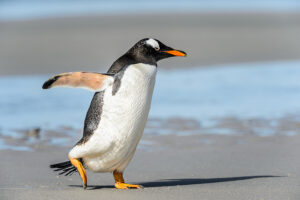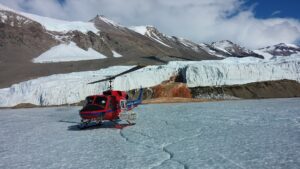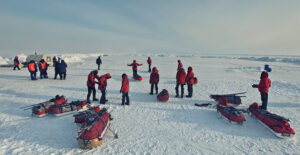Antarctica has shown the class of 2022 its teeth for the first time, as high winds stopped most expeditions for at least a day. However, there have also been some bluebird days and mild weather.
Crossings
Gareth Andrews and Richard Stephenson
Andrews and Stephenson continue to ramp up their daily distances, taking advantage of great weather and hard-packed snow. On day 11 they experienced “the best weather Antarctica has to offer” and duly churned out over 22km, their longest so far. Day 12 brought more clear skies and another 22km. Then they smashed out 23.5km on both day 13 and 14.
Aware that the incredible weather won’t hold forever, they took the opportunity to have a snow bath on day 15, hoping to “temporarily mute the rising stink”. At -10°C, it will have been a bracing experience.
On day 16, the weather turned. The morning’s tailwind and hard-packed snow turned into softer snow and decreased visibility as the afternoon progressed. They nevertheless covered 24km, mostly in the morning.
Over the next two days, the soft snow slowed their progress back to below 20km per day. The deep, soft snow has been draining, but the duo celebrated a significant milestone. They completed stage one of their expedition and left Berkner Island.
“As we start the crossing of the Ronne-Filchner Ice Shelf, we have 1,650km to go to get to the bottom of the Reedy Glacier and the Ross Ice Shelf,” they explained. “After losing our crucial first week to weather delays, we now have 48 days to complete the crossing.”
If their 48 days are binding (in terms of supplies), completing the journey will be a seriously tough ask. They’ll need to stack up over 34km each day, a significant jump from even their longest day so far.
Preet Chandi
On November 26, with the wind picking up, ALE warned Chandi to expect a storm the following day. The next afternoon, she stopped early to secure her tent before the winds reached their peak of around 100kph.

Nobody enjoys the bumpy sastrugi. Photo: Preet Chandi
The next three days brought calmer conditions and good visibility. However, they also brought more sastrugi.
“I am still wearing long skins on my skis, which help me grip,” Chandi said in her latest update. “I will change them over to my short skins as soon as my pulk starts to feel lighter. It has been tough so far but I’m doing OK.”
Six-person Australian team
The Australian team also hunkered down to avoid the worst of the wind, staying in camp on November 26. The next few days offered clear, warm weather but also some soft snow.
They have noticed an easing of the sastrugi as the terrain flattens out. They still need to increase their daily distances. Despite a recent 25km day they are averaging below 14km.
Hercules Inlet to the South Pole
On November 27, Mikko Vermas and Tero Teelahti finally began their uphill slog from Hercules Inlet toward the Antarctic plateau.
The first three days were slow. They covered around 13km each day and battled both the incline and the wind. On day four, the wind won out and they took a rest day. “Weakness of the mind…but we are in no hurry to wear out our strength on this start,” they said.
Their daily updates have been quiet since November 30. Hopefully, they are busy knocking over the kilometres.
Norwegian solo skier Hedvig Hjertaker set off on November 27. She made a solid start before a windbound day on December 1, during which she spent 24 hours in her sleeping bag.
Korean Young Mi Kim waited six days in Union Glacier for the weather to clear. She finally flew to Hercules Inlet late on November 26. She has not updated since but should have set off the following morning.
Mateusz Waligora is struggling. He detests tomato soup. “Tomato soup for breakfast!” he said. “Such a day couldn’t have been any worse. No matter what may happen. And beautiful things did happen. The wind died, the sky became better, and the fluff floating in the air…did not interfere with the march. Effect? 22.9 kilometres!”

Mateusz Waligora’s skis. Photo: Mateusz Waligora
Thus far, Waligora is comfortably the most interesting expedition to follow. He’s been arguing with the legendary Norwegian explorer Fridtjof Nansen (or at least the image of him, printed on his skis) to “keep from going crazy”. He has been listening to a podcast about a man who was bitten on the behind by a polar bear.
Ben Weber was struggling last week, with neck and back pain forcing some time off. After his second rest day on day 6, he continued and managed a slow, painful 10km. The slow pace was by design. After his first rest day, he had felt good, only to overdo it and retire to his tent in agony.
Like other skiers, Weber was stuck in the tent the following day as a storm rolled in. The extra rest may have done his neck some good. He increased his daily distance each day after the storm had passed. He topped 20km for the first time on day 13.
Unfortunately, the neck pain soon returned. By day 16, he decided on another rest day, as well as a medical resupply from ALE. The logistics of the resupply are still to be worked out.
Cycling across Antarctica
Cyclist Omar Di Felice has started pedaling from Hercules Inlet. Thus far, he is actually pedaling. He estimates that his first two days “have passed cycling 60% of the time and pulling the bike and sled for the remaining 40%”.

Di Felice is managing to spend most of his time on the bike, rather than pushing it. Photo: Omar Di Felice
But the positive start has ground to a halt in the wind. Di Felice has been tent bound for the last 72 hours.
“I wouldn’t have imagined such a complicated start,” he said. “The only possible [actions] are to free the tent from the snow and melt snow to have something to drink and eat. I’m very close to the point where I will turn south but the wind doesn’t seem to let me pass.”
Guided groups from the Messner Start
The 10-person “Inspire 22” team guided by Canadian Devon McDiarmid is finally underway, after delays in Punta Arenas and Union Glacier. They’ve made a solid start, ramping up to 20km by day four on the ice.

The Ousland Explorers team out on the ice. Photo: Ousland Explorers
The Ousland Explorers team is now two weeks in. “The grind is real, but the views are worth it,” team member Laura Andrews wrote in a recent update. On day 9, they waited out strong winds and they’ve been battling building fields of sastrugi as they advanced.
According to the Norwegians, the Kiwis have “started to embrace the smell of Norwegian fish”. All I can surmise is that Antarctica must be particularly brutal this year.






